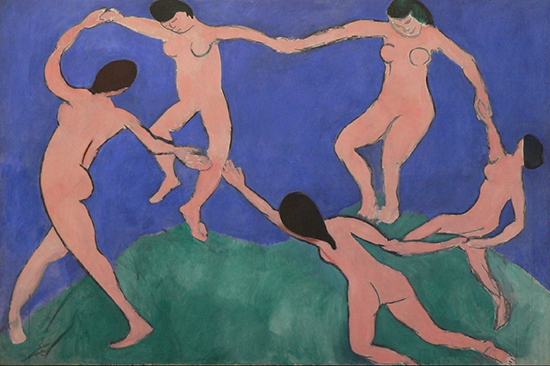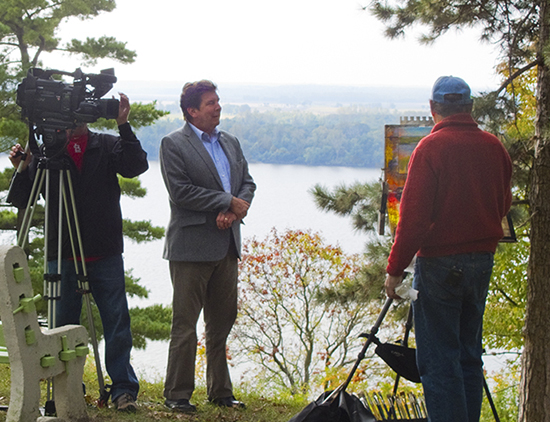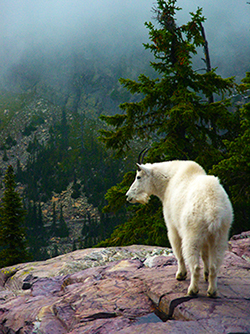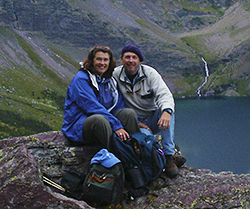Plein Air Painting in Rain by Marc DalessioPlein Air Painting in Rain 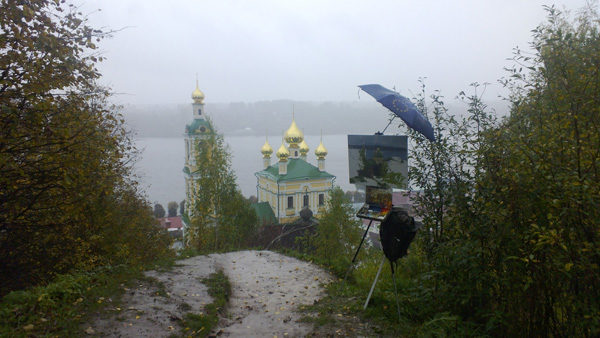
Painting in the rain in Plyos, Russia Marc Dalessio shares with us his tips on painting outdoors in difficult conditions. We had the opportunity to interview Dalessio previously on The Artist's Road. (See: Marc Dalessio Profile.) "Plein Air Painting in Rain" is reprinted here with permission from the artist. To see more of Dalessio's work and musings please visit his website.
There are inspiring natural effects which take place in weather which is not really suited to plein air painting. I wrote earlier in the year about painting in snow, rain is another such condition. For cityscapes and roads especially, painting while it is raining can offer reflections in the wet pavement which make for some wonderful designs and unusual compositions. 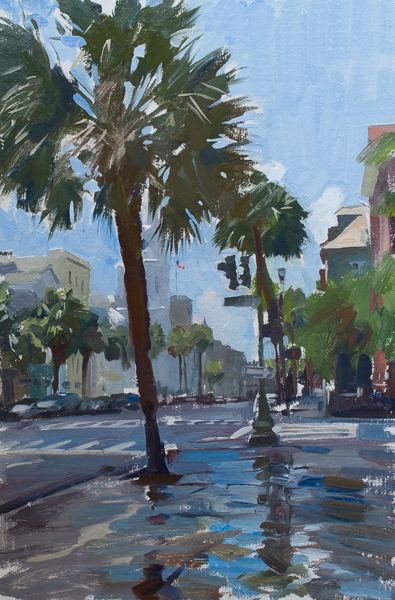 After the Rain, Broad Street, Charleston 12 x 8" Oil 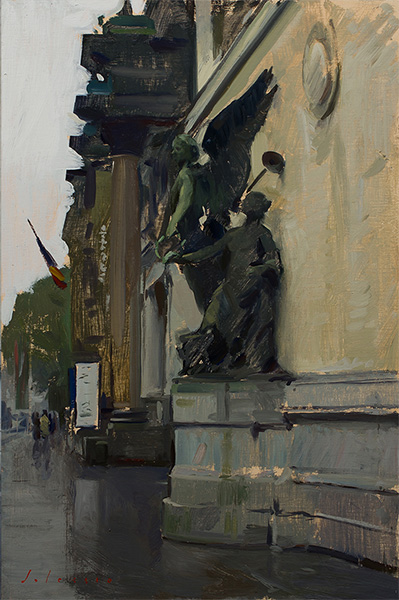 The Fin-de-Siècle Museum in the Rain 30 x 20 cm Oil There are, however, difficulties with using oil paint in heavy or persistent rain. First, when the painting surface is covered with a sheet of water it can be difficult to get the colors to stick. Then poorly mulled paints can bleed with the water. Next, heavier drops of water can hit the delicate paint layers, leaving small craters in the color or washing away the paint altogether. And finally, with enough perseverance, one discovers that the the old adage ‘oil and water don’t mix’ is only partly true: oil paint will eventually mix with the water to form a thick emulsion which can be difficult to control. The obvious solution to this is to keep water off the surface, either by painting somewhere with shelter or to carrying one’s shelter to the spot. A top-hinged trunk door can work very well for painters with one on their car (thanks Roy Connelly), as shown in this photo of my set-up under the trunk of a car on the Hardangerfjord. 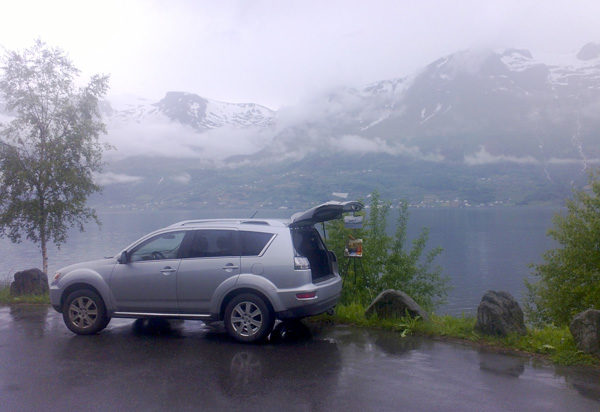
Using a Trunk Door as a Portable Painting Shelter in Norway Recently I built a small, lightweight rain-bonnet which attaches to my easel above the panel. As I wanted something that would fit in my backpack, the set-up is quite small. It works fine in normal vertical rain, but isn’t all that successful with the horizontal and upward-directed rain that you get in places like Ireland. Once I’ve tweaked it to better functionality I’ll try to get them out to the public.  Rain Bonnet for Plein Air Painting in Rain Rain Bonnet for Plein Air Painting in RainAnother option is an umbrella. I have an Easy L umbrella from Artwork Essentials, which is made from opaque cloth and designed for blocking sunlight, not rain. The problem with an opaque or dark umbrella in the rain is that it blocks what little light is filtering down from above. This can be especially problematic when painting in cities or forests where much of the ambient light is already blocked from the sides. A better solution would be a white umbrella like the ones made by Best Brella. While I have no personal experience with their products, I’ve seen painters with other clip-on white umbrellas that let in adequate light for keying values properly. 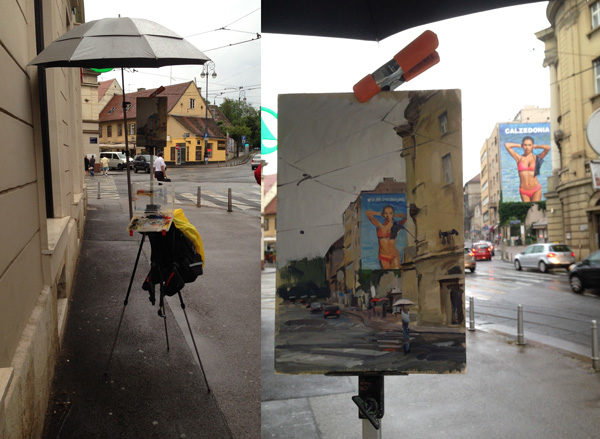
Dark Umbrellas Block Too Much Light in Overcast Conditions A serious problem with painting in heavy rain is that it can absolutely ruin materials. For brushes, the thickness of the emulsion and water sinking into the wood handle can expand the metal ferrule which, in turn, causes hairs to come out and destroys the form of the head. When working outside in dry weather I can get away with washing my brushes once a week if I use them everyday. When painting in heavy rain I find I need to get the paint and water out of the brush at the end of every day, and even then some don’t make it. I haven’t had problems with wet panels warping, but I have seen water soak the linen and cause it to shrink. This can lead to bending of the stretcher bars as seen in Leo Mancini-Hresko‘s photo below. The solution would be heavier stretcher bars with a crossbar, and/or restretching the canvas after the painting is finished. 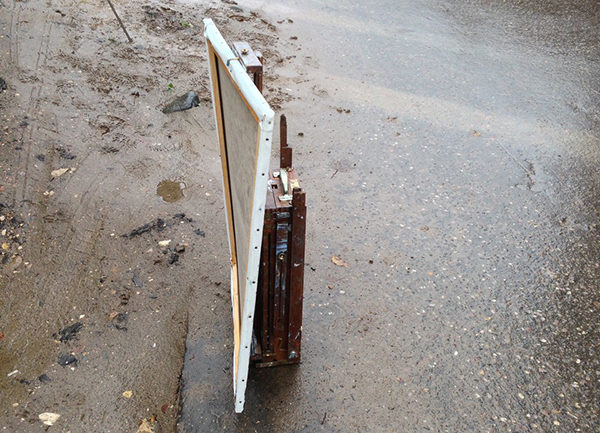
Warped Stretcher Bars due to the Linen Shrinking while Drying As for rain clothes, there are better sites to peruse for gear. I’m personally a fan of Gore-Tex Paclite as it’s cheaper than, and doesn’t breathe as well as the fancier alpinist/backpacker stuff. I find that clothes that don’t breathe well are better for us stationary landscape painters, yet some venting is better so it doesn’t feel suffocating or clammy. I have an old Patagonia Paclite jacket that I’ve used for a number of years if I know it’s going to rain. I wash it and reapply Grangers waterproofing once or twice a year. As I mentioned in the post on winter clothes, alpinist and climbing jackets are stitched together in a way to minimize the pull on your sleeves when you lift your arm. This works better for painters than normal jackets as we also keep our arms up much of the time. A dark and/or blue jacket is also a good idea for painting en plein air as it wont reflect a strong color back onto the canvas if the sun comes out. I’ve experimented recently with a lightweight Helium II from Outdoor Research and one of the new Derzimax jackets from Bergans of Norway. Neither was particularly impressive—the Helium packs small and weighs little, but it wets out quickly and feels clammy. The Derzimax jacket keeps me dry, breathes well (which can feel cold when stationary), dries quickly, but weighs four times as much as the Helium, and twice as much as my Patagonia. Painting in freezing rain can be a problem as one needs all the warmth of insulating layers, with a waterproof shell on top. In the past I found the only way to do this was with the aforementioned layers or a very heavy parka, both of which are constricting and heavy, and annoying to paint in. This year I picked up a lightweight Crux eVent down jacket from Up and Under in Cardiff (great UK gear store), which should be both warm and waterproof for painting in winter rain. I'll let you know how it works out. eVent is suppose to have problems if it gets dirt or grease on it, and I assume the same would go for oil paint, but it was the only lightweight, articulated-shouldered, one-jacket solution I could find. 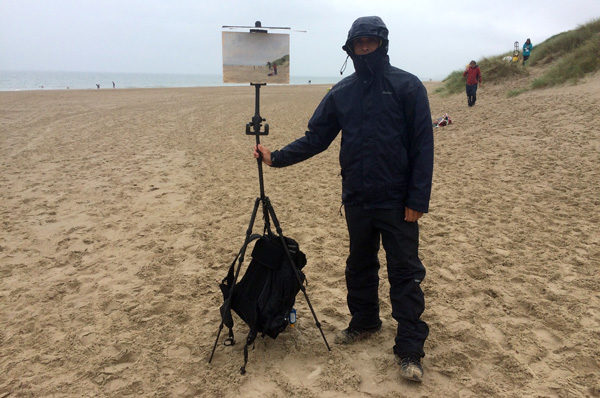
Painting in the Rain on Curracloe Beach in Ireland For rain pants I use a Berghaus Paclite shell that can be found pretty inexpensively on Amazon.co.uk. 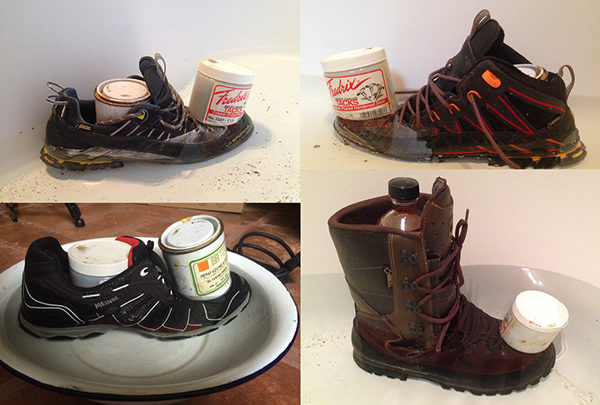
Bathtub test: Meindls (bottom) didn’t let water in after hours, La Sportivas (top) leaked like sieves It took me forever to find actual waterproof shoes that were light enough to travel with. While I love the grippy soles of La Sportiva approach shoes and trailrunners (red Frixion soles), their Gore-Tex iterations are a trainwreck. When wearing them my socks will get wet after crossing a lawn covered with dew. I’ve had good luck with Meindl boots so I’ve been using their X-SO 30 shoes with Gore-Tex Surround and, combined with waterproof gaiters, they keep my feet dry for hours in the rain. The downside to Meindl is they can be hard to find, expensive, and they look like they were designed by a 1980s glam rock group. On the plus side they’re still made in Germany and last for years. 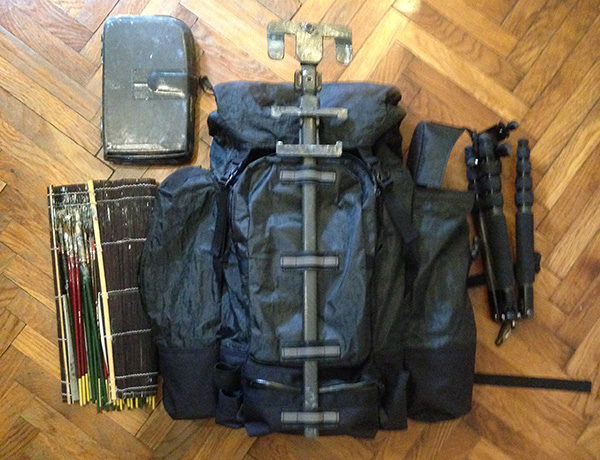
Custom Cuben Fiber Backpack for Painting Equipment For keeping my gear dry, I had a Cuben Fiber (now Dyneema Composites Fabric) backpack made by an artisan in Florence. My main interest at the time was actually to keep medium and turpentine from getting out of the backpack, should something leak. But the Cuben Fiber is completely waterproof, so my paintings and brushes are protected once they get back into the bag. I was a bit concerned about how Cuben Fiber would react with the medium and especially with the turpentine, but it’s worked great so far. I’ve used it daily for six months with turpentine and medium on the inside and outside of the bag there are no ill effects. It wipes off easily too.
|
Become an Artist's Road Member Today!
Already a Member?Log in here. To renew your membership, log in and follow the links. Search the SitePerspectivesNot ready to become a Member yet? Subscribe to our free email postcards, "Perspectives". Enter your email address here.
Member ContentFree ContentThe Artist's Road StoreNocturnes - A Primer on Night Painting Filled with inspirational examples by the masters of nightime painting, this little book is sure to fire up your creative energies. Never tried painting at night? We show you how it's done with a step-by-step-oil demo and a tale of night painting in the wilds of Rocky Mountain National Park. The Primer on Night Painting - Nocturnes is a 7 x 7" PDF download with 40 pages of text and images. It includes a gallery of paintings by masters of the nocturne, information to inspire and encourage you in your plein air nocturne painting, an illustrated step-by-step demo and tips for working in pastel and oil. Also available in a softcover edition. Check out the tools and other products that we use in our own art and travels in The Artist's Road Store. We only offer things for sale that we enthusiastically believe in.
About Us
|
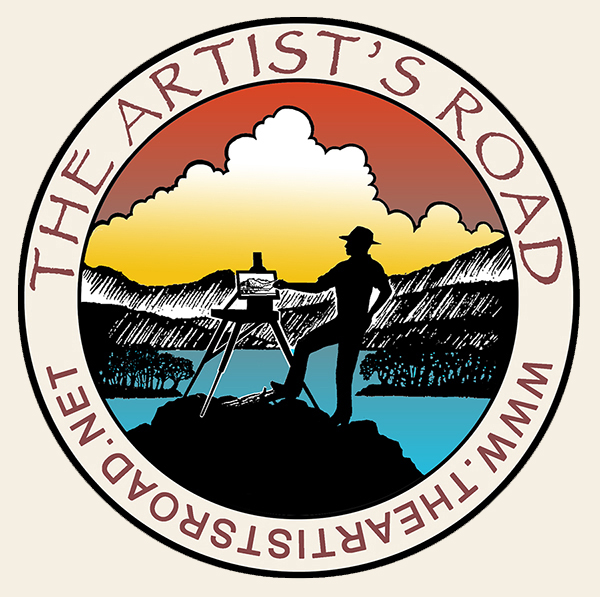
 Voices of Experience:Christine Code
Voices of Experience:Christine Code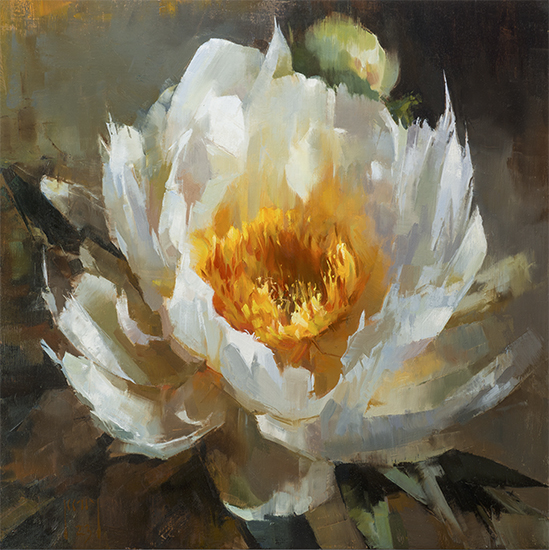
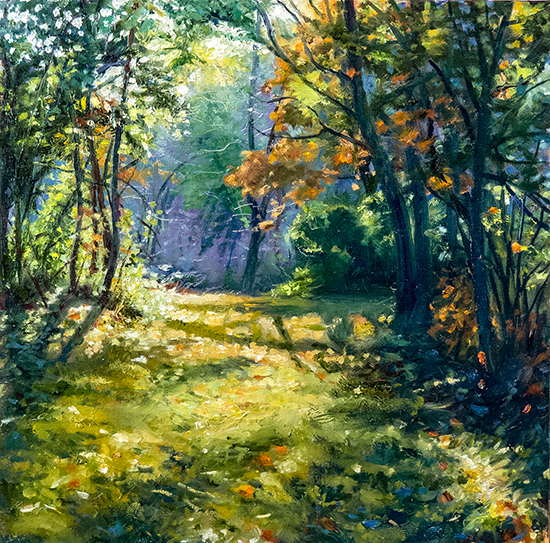
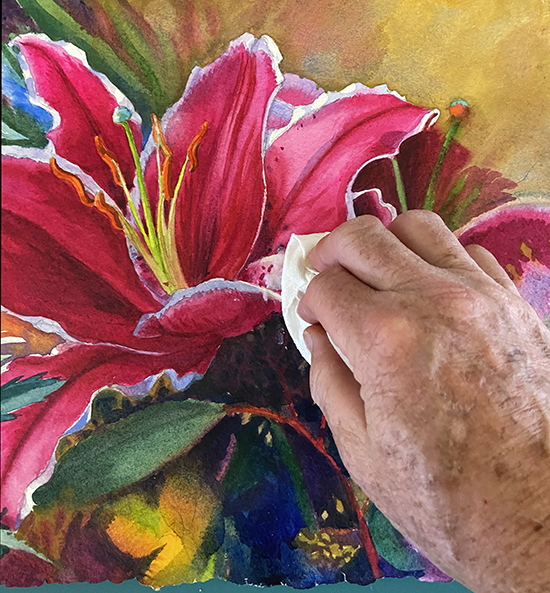 ing Watercolors
ing Watercolors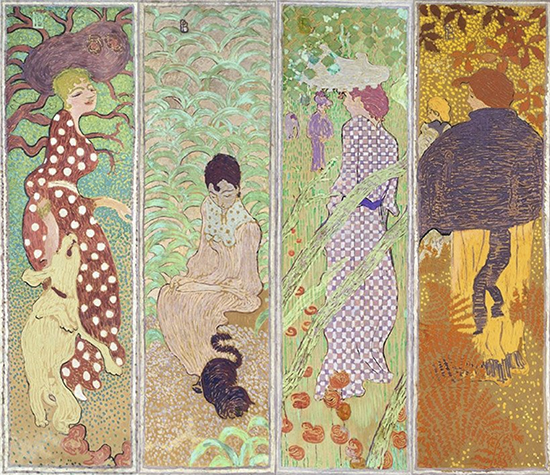
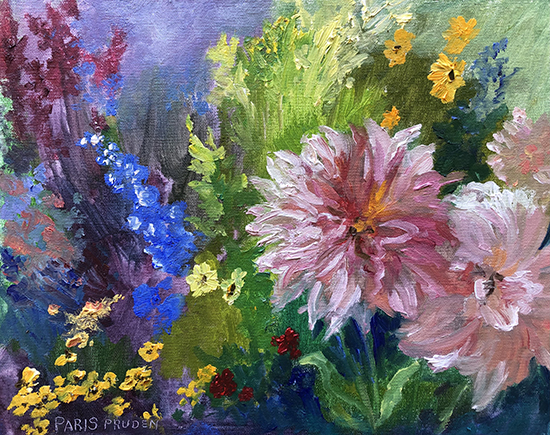
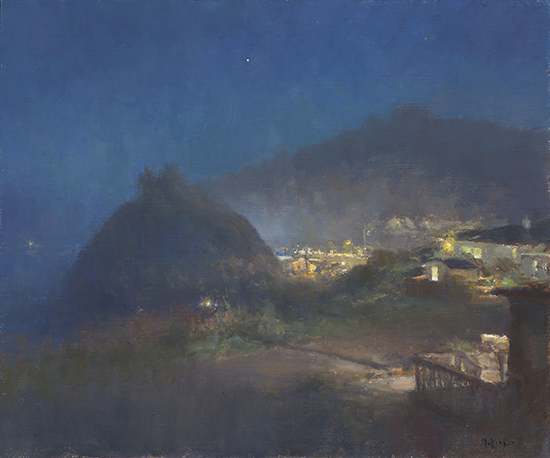
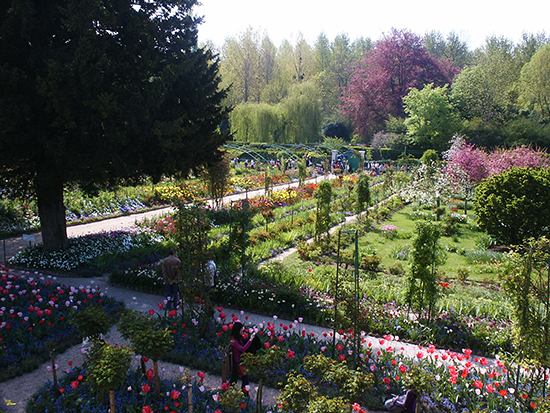 Inspiration in Monet's Gardens
Inspiration in Monet's Gardens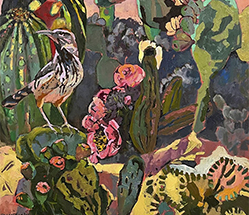
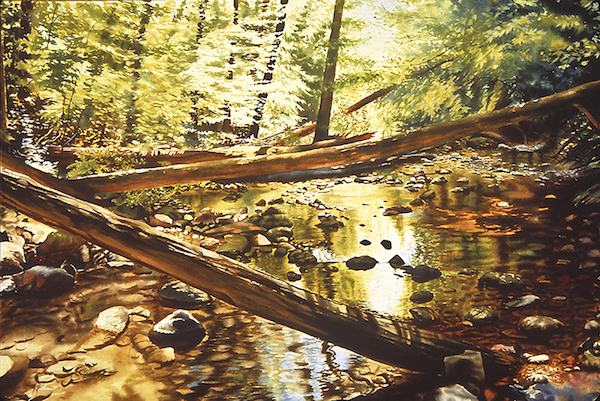 The Watercolor Medium
The Watercolor Medium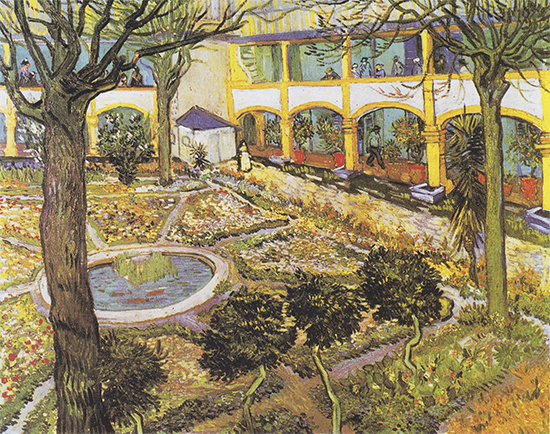 Paintings & Their Places
Paintings & Their Places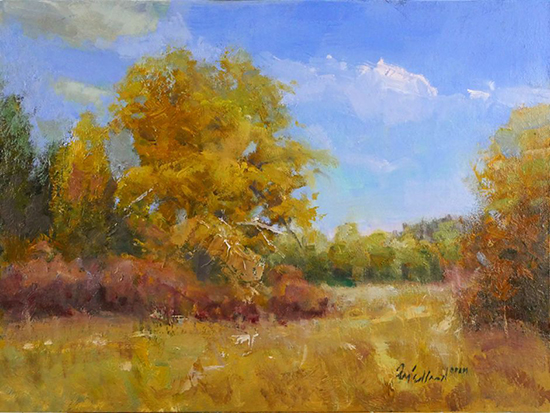
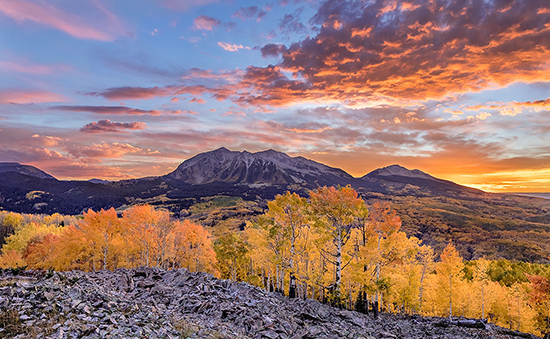 Essential Photo Tools for the Landscape Artist
Essential Photo Tools for the Landscape Artist